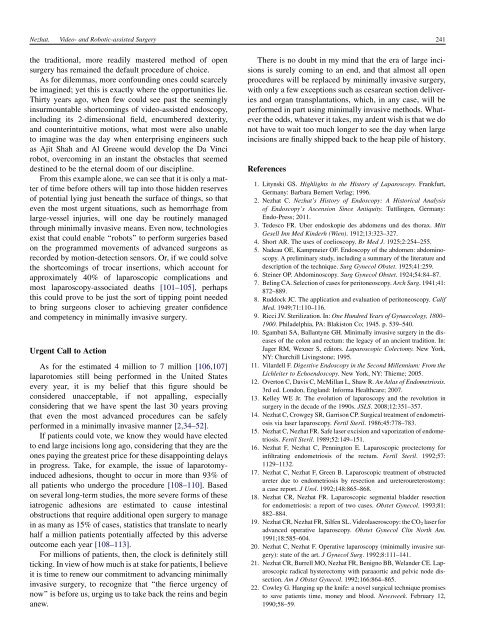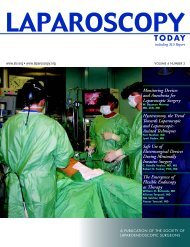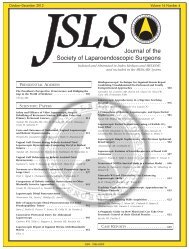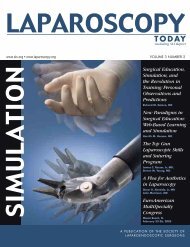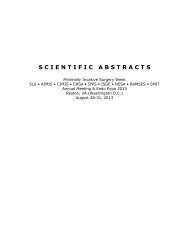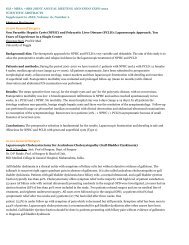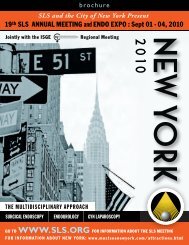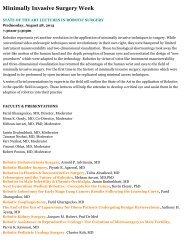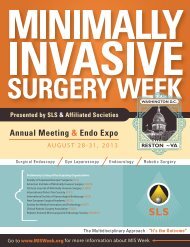Abstract/Article - Laparoscopy Today
Abstract/Article - Laparoscopy Today
Abstract/Article - Laparoscopy Today
You also want an ePaper? Increase the reach of your titles
YUMPU automatically turns print PDFs into web optimized ePapers that Google loves.
Nezhat. Video- and Robotic-assisted Surgery 241<br />
the traditional, more readily mastered method of open<br />
surgery has remained the default procedure of choice.<br />
As for dilemmas, more confounding ones could scarcely<br />
be imagined; yet this is exactly where the opportunities lie.<br />
Thirty years ago, when few could see past the seemingly<br />
insurmountable shortcomings of video-assisted endoscopy,<br />
including its 2-dimensional field, encumbered dexterity,<br />
and counterintuitive motions, what most were also unable<br />
to imagine was the day when enterprising engineers such<br />
as Ajit Shah and Al Greene would develop the Da Vinci<br />
robot, overcoming in an instant the obstacles that seemed<br />
destined to be the eternal doom of our discipline.<br />
From this example alone, we can see that it is only a matter<br />
of time before others will tap into those hidden reserves<br />
of potential lying just beneath the surface of things, so that<br />
even the most urgent situations, such as hemorrhage from<br />
large-vessel injuries, will one day be routinely managed<br />
through minimally invasive means. Even now, technologies<br />
exist that could enable ‘‘robots’’ to perform surgeries based<br />
on the programmed movements of advanced surgeons as<br />
recorded by motion-detection sensors. Or, if we could solve<br />
the shortcomings of trocar insertions, which account for<br />
approximately 40% of laparoscopic complications and<br />
most laparoscopy-associated deaths [101–105], perhaps<br />
this could prove to be just the sort of tipping point needed<br />
to bring surgeons closer to achieving greater confidence<br />
and competency in minimally invasive surgery.<br />
Urgent Call to Action<br />
As for the estimated 4 million to 7 million [106,107]<br />
laparotomies still being performed in the United States<br />
every year, it is my belief that this figure should be<br />
considered unacceptable, if not appalling, especially<br />
considering that we have spent the last 30 years proving<br />
that even the most advanced procedures can be safely<br />
performed in a minimally invasive manner [2,34–52].<br />
If patients could vote, we know they would have elected<br />
to end large incisions long ago, considering that they are the<br />
ones paying the greatest price for these disappointing delays<br />
in progress. Take, for example, the issue of laparotomyinduced<br />
adhesions, thought to occur in more than 93% of<br />
all patients who undergo the procedure [108–110]. Based<br />
on several long-term studies, the more severe forms of these<br />
iatrogenic adhesions are estimated to cause intestinal<br />
obstructions that require additional open surgery to manage<br />
in as many as 15% of cases, statistics that translate to nearly<br />
half a million patients potentially affected by this adverse<br />
outcome each year [108–113].<br />
For millions of patients, then, the clock is definitely still<br />
ticking. In view of how much is at stake for patients, I believe<br />
it is time to renew our commitment to advancing minimally<br />
invasive surgery, to recognize that ‘‘the fierce urgency of<br />
now’’ is before us, urging us to take back the reins and begin<br />
anew.<br />
There is no doubt in my mind that the era of large incisions<br />
is surely coming to an end, and that almost all open<br />
procedures will be replaced by minimally invasive surgery,<br />
with only a few exceptions such as cesarean section deliveries<br />
and organ transplantations, which, in any case, will be<br />
performed in part using minimally invasive methods. Whatever<br />
the odds, whatever it takes, my ardent wish is that we do<br />
not have to wait too much longer to see the day when large<br />
incisions are finally shipped back to the heap pile of history.<br />
References<br />
1. Litynski GS. Highlights in the History of <strong>Laparoscopy</strong>. Frankfurt,<br />
Germany: Barbara Bernert Verlag; 1996.<br />
2. Nezhat C. Nezhat’s History of Endoscopy: A Historical Analysis<br />
of Endoscopy’s Ascension Since Antiquity. Tuttlingen, Germany:<br />
Endo-Press; 2011.<br />
3. Tedesco FR. Uber endoskopie des abdomens und des thorax. Mitt<br />
Gesell Inn Med Kinderh (Wien). 1912;13:323–327.<br />
4. Short AR. The uses of coelioscopy. Br Med J. 1925;2:254–255.<br />
5. Nadeau OE, Kampmeier OF. Endoscopy of the abdomen: abdominoscopy.<br />
A preliminary study, including a summary of the literature and<br />
description of the technique. Surg Gynecol Obstet. 1925;41:259.<br />
6. Steiner OP. Abdominoscopy. Surg Gynecol Obstet. 1924;54:84–87.<br />
7. Beling CA. Selection of cases for peritoneoscopy. Arch Surg. 1941;41:<br />
872–889.<br />
8. Ruddock JC. The application and evaluation of peritoneoscopy. Calif<br />
Med. 1949;71:110–116.<br />
9. Ricci JV. Sterilization. In: One Hundred Years of Gynaecology, 1800–<br />
1900. Philadelphia, PA: Blakiston Co; 1945. p. 539–540.<br />
10. Sgambati SA, Ballantyne GH. Minimally invasive surgery in the diseases<br />
of the colon and rectum: the legacy of an ancient tradition. In:<br />
Jager RM, Wexner S, editors. Laparoscopic Colectomy. New York,<br />
NY: Churchill Livingstone; 1995.<br />
11. Vilardell F. Digestive Endoscopy in the Second Millennium: From the<br />
Lichleiter to Echoendoscopy. New York, NY: Thieme; 2005.<br />
12. Overton C, Davis C, McMillan L, Shaw R. An Atlas of Endometriosis.<br />
3rd ed. London, England: Informa Healthcare; 2007.<br />
13. Kelley WE Jr. The evolution of laparoscopy and the revolution in<br />
surgery in the decade of the 1990s. JSLS. 2008;12:351–357.<br />
14. Nezhat C, Crowgey SR, Garrison CP. Surgical treatment of endometriosis<br />
via laser laparoscopy. Fertil Steril. 1986;45:778–783.<br />
15. Nezhat C, Nezhat FR. Safe laser excision and vaporization of endometriosis.<br />
Fertil Steril. 1989;52:149–151.<br />
16. Nezhat F, Nezhat C, Pennington E. Laparoscopic proctectomy for<br />
infiltrating endometriosis of the rectum. Fertil Steril. 1992;57:<br />
1129–1132.<br />
17. Nezhat C, Nezhat F, Green B. Laparoscopic treatment of obstructed<br />
ureter due to endometriosis by resection and ureteroureterostomy:<br />
a case report. JUrol. 1992;148:865–868.<br />
18. Nezhat CR, Nezhat FR. Laparoscopic segmental bladder resection<br />
for endometriosis: a report of two cases. Obstet Gynecol. 1993;81:<br />
882–884.<br />
19. Nezhat CR, Nezhat FR, Silfen SL. Videolaseroscopy: the CO 2 laser for<br />
advanced operative laparoscopy. Obstet Gynecol Clin North Am.<br />
1991;18:585–604.<br />
20. Nezhat C, Nezhat F. Operative laparoscopy (minimally invasive surgery):<br />
state of the art. J Gynecol Surg. 1992;8:111–141.<br />
21. Nezhat CR, Burrell MO, Nezhat FR, Benigno BB, Welander CE. Laparoscopic<br />
radical hysterectomy with paraaortic and pelvic node dissection.<br />
Am J Obstet Gynecol. 1992;166:864–865.<br />
22. Cowley G. Hanging up the knife: a novel surgical technique promises<br />
to save patients time, money and blood. Newsweek. February 12,<br />
1990;58–59.


